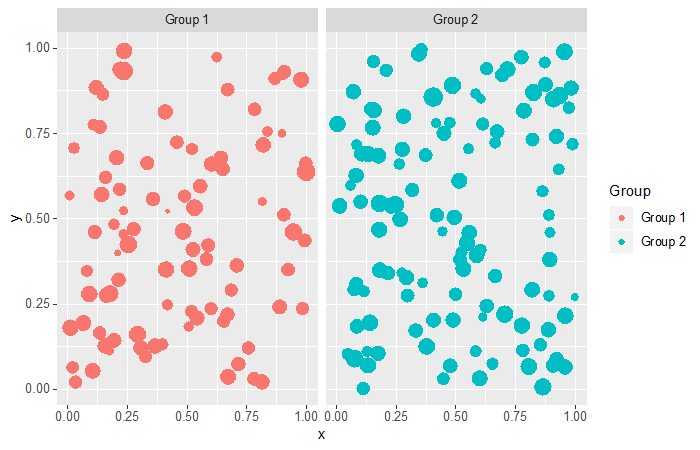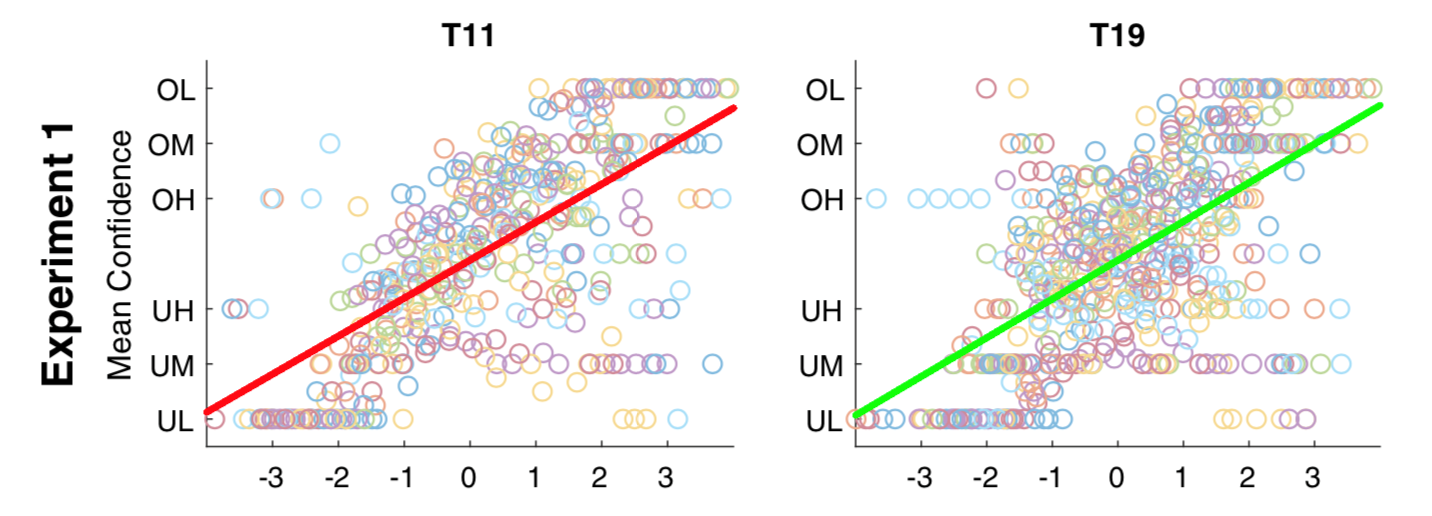In some parts of New York state, it recently snowed 18 inches (~45 centimeters) following a major winter storm. With every hour, the snow piled higher and higher – but some of the increments in accumulation, especially toward the beginning, felt bigger, while others took longer to notice. You might even have the feeling that you’re less certain about whether a change has happened the higher the snow piles up.
The role of uncertainty in how we make our judgments about a difference in magnitude touches more than just our interaction with snow, but also time, distance, temperature, linguistic frequency, and lots more.
The exact way that people keep track of quantities is unknown, but there seems to be a common mechanism involved when individuals judge quantities. When we cannot count reliably, we rely on the approximate number system, illustrated below. Which group – Group 1 or Group 2 – do you think has more dots?

This judgment was presumably quite easy. (There are 90 dots in the left chart, and 115 on the right).
In humans, the approximate number system starts at quantities of about 4, which is the typical limit below which we can distinguish all counts. That is, we can instantly tell whether we look at 1, 2, 3, or 4 marbles (or dots or whatever), an ability known as subitizing. But after 4, people typically have to start counting by hand in order to maintain accuracy or they resort to approximation. The higher the numbers involved, the more likely that judgments of quantity are to be incorrect.
Though the approximate number system is ubiquitous in counting problems, it also relates to measures of continuous quantity, such as the duration of an event or sound. The approximate number system seems to be engaged in many different kinds of quantity judgments, bolstered by convergent brain evidence showing that similar areas of the brain are engaged during many different kinds of experiments.
Perhaps most remarkably about judgments of quantity is that individuals can usually guess whether they are over- or underestimating their judgments. What is less clear is whether people can do this for a wide variety of tasks, such as counting discrete events, which is less like guessing the duration of an event than it is like counting groups of objects, but somewhat similar to both.
In a recent article in the Psychonomic Bulletin and Review, researchers Yalcin Duyan and Fuat Balcı looked into exactly how people keep track of the numbers of events, and whether they are aware of how potentially inaccurate their estimates might be, and in what direction (over or under). In two experiments, Duyan and Balcı tested whether participants’ judgments of the size of their errors was correlated with how far they actually were from the correct answer. Experiment 1 tested quantities of 11 and 19, while Experiment 2 tested quantities of 7 and 11.
Experiment 1, visualized in the figure below, focused on whether people are capable of guessing their errors in counting numbers of events. In this experiment, participants heard either a sequence of 11 or 19 beeps presented for a short period of time (60 ms) with breaks between beeps ranging from 300 and 600 milliseconds. Participants were instructed to press a key when they believed the number of beeps on a given trial had reached either 11 or 19. Afterward, they rated their confidence in their answer (low, medium, or high) and then judged whether they over- or undershot the target number. There were a total of four 13-minute blocks with this structure.

If participants are aware of whether they over- or undershoot estimates of the number of beeps, then their responses should correlate with how much they actually over- or undershot those estimates and with how confident they are. If participants perfectly estimate their errors, then there should be a nearly 1-to-1 correspondence between their ratings and their performance.
On average, participants were highly capable of predicting how incorrect they were and in which direction. The more strongly the evidence pointed toward a high numerosity (i.e., 19), the more likely participants were to say they over-estimated the total. Similarly, the lower the numerosity, the more likely they were to say they had underestimated the total. This shows that people are highly capable of predicting the quantity as well as whether they are likely to be wrong. Their results for this experiment are reproduced below. The results differ slightly for their second experiment in the paper, at which they tested smaller numbers (7 and 11), but those results are qualitatively similar.

The authors were somewhat concerned about the potential confound between time (duration from the beginning of the trial and the amount of time at which a participant stated that they reached a given trial number) and beep number. These are correlated to some extent in that higher numbers are almost always later in a given trial. If time was all participants used, then it would be unclear that they are using uncertainty in number at all. Instead, they could just guess that they have taken too long on average. When considering the smaller numerosity (11), the raw number of beeps, rather than the amount of time, was a better predictor of participants’ accuracy. On the other hand, the number of beeps and the amount of time participants took to make a response were both equally predictive of participants responses for the larger numerosity (19). Overall, it appears that participants were actually using the quantity of beeps and not just a proxy for the amount of time that has elapsed.
In light of the results of their study, Duyan and Balcı ask why we might not guess the right target the first time, if we have a sense of how wrong we are in counting or estimating quantities. Some of their previous research hinted at a possibility that this judgment is determined by a separate cognitive process – individuals can calculate their mistakes but only after the fact. So, participants who judge later how wrong they were, likely did not have access to that judgment earlier.
The work is most important in its demonstration that people are just as able to estimate counts of events as they are other types of magnitude – lengths, durations, weights, volumes, and so on. The fact that our behavior across these different judgment types is so similar suggests that there may be a shared architecture for the general judgment of quantity.
Featured in this post:
Duyan, Y. A., & Balcı, F. (2018). Numerical error monitoring. Psychonomic Bulletin & Review, 25, 1549-1555. doi: 10.3758/s13423-018-1506-x
